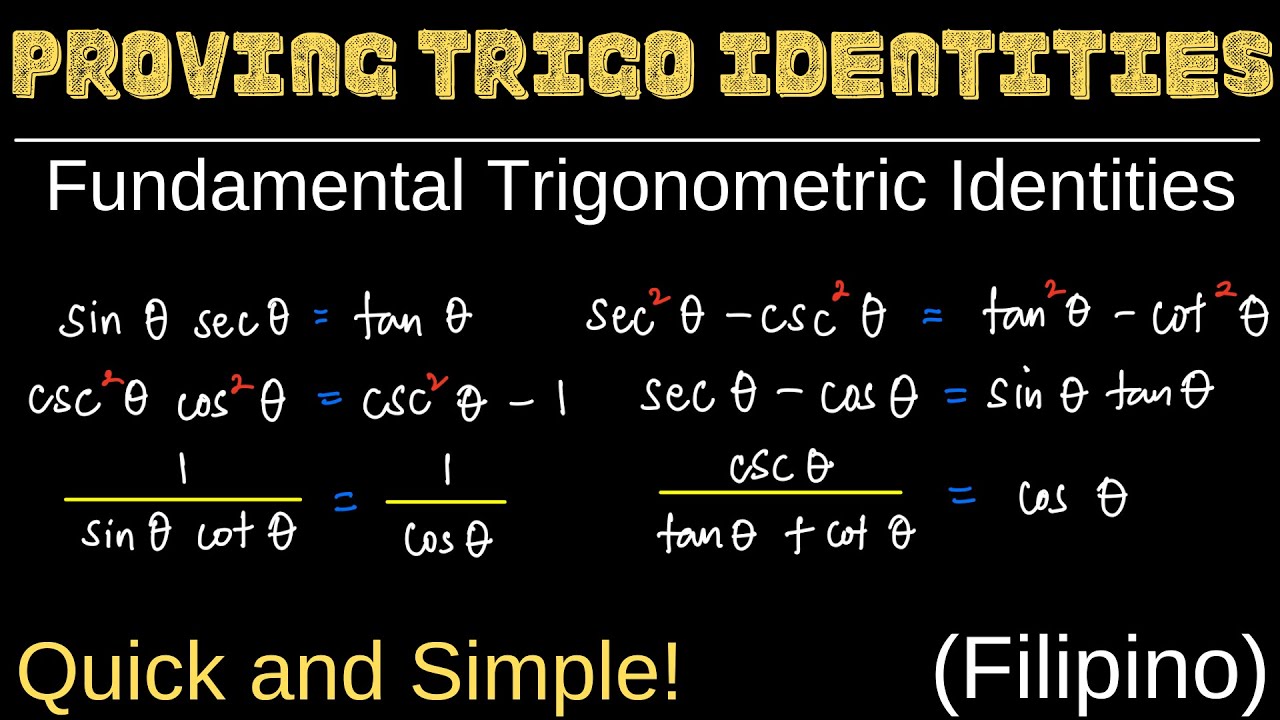Super Hexagon for Trigonometric Identities | Trigonometry | Infinity Learn
Summary
TLDRThe video introduces the concept of a 'super hexagon' as a visual tool to help remember and derive various trigonometric formulae and identities. By organizing the six trigonometric functions (sine, cosine, tangent, cotangent, secant, and cosecant) at the vertices of a hexagon, key relationships and formulae can be revealed by following specific paths around the hexagon. The super hexagon simplifies complex trigonometric equations, including identities like reciprocal, complementary angle relationships, and Pythagorean identities. The video emphasizes practice and understanding of the concepts rather than memorization.
Takeaways
- 🛑 The super hexagon helps remember trigonometric formulae by organizing functions in a simple hexagon structure.
- 🔺 Opposite vertices of the hexagon are connected by diagonals, with the number 1 placed at the center.
- 🌀 Six trigonometric functions are assigned to the six vertices, starting with tan, sine, and cos, followed by cot, cosec, and sec.
- 🔄 The relationships between the functions follow a pattern where moving clockwise or counterclockwise yields various trigonometric identities.
- 💡 Functions at opposite vertices are reciprocals of each other, like sine and cosec, cos and sec, and tan and cot.
- 🧮 Multiplying functions at diagonally opposite vertices results in 1 (e.g., sine * cosec = 1).
- 🔗 When taking three continuous functions, multiplying the first and third gives the middle one (e.g., tan * cos = sine).
- ♾️ The hexagon reveals complementary angle relationships, such as sine(θ) = cos(90° - θ) and tan(θ) = cot(90° - θ).
- 📐 The hexagon also helps visualize Pythagorean identities, such as sine²θ + cos²θ = 1, and similar identities for cot and cosec, tan and sec.
- 🚩 Moving anti-clockwise within triangles formed inside the hexagon introduces subtraction into these identities (e.g., 1 - cos²θ = sine²θ).
Q & A
What is the purpose of the super hexagon in trigonometry?
-The super hexagon is a visual tool designed to help remember various trigonometric identities and formulae. By placing trigonometric functions at each vertex and connecting diagonally opposite vertices, it helps in deriving and recalling multiple relationships between the functions.
How are the six trigonometric functions placed on the super hexagon?
-The functions are placed as follows: starting with tan, sine, and cosine in a clockwise direction, then cotangent (opposite tan), cosecant, and secant on the right side (all 'c' functions are on the right).
What is the first trigonometric identity derived from the super hexagon?
-The first identity is tan(theta) = sin(theta) / cos(theta), which is used as the basis for placing the functions in the hexagon.
What happens when you go around the hexagon in a clockwise direction?
-When moving clockwise, the first function equals the second function divided by the third function. For example, tan(theta) = sin(theta) / cos(theta), sin(theta) = cos(theta) / cot(theta), and so on.
Does the formula pattern hold if you go anti-clockwise around the hexagon?
-Yes, the pattern holds true in the anti-clockwise direction as well. For example, tan(theta) = sec(theta) / cosec(theta), and similarly for other functions.
What happens when you multiply the functions at opposite vertices?
-When multiplying functions at diagonally opposite vertices, the result is always 1. For example, sin(theta) * cosec(theta) = 1, cos(theta) * sec(theta) = 1, and tan(theta) * cot(theta) = 1.
What is the rule for the product of three continuous functions in the hexagon?
-The product of the first and third function in any sequence of three continuous functions equals the middle function. For example, tan(theta) * cos(theta) = sin(theta).
How does the super hexagon illustrate reciprocal functions?
-The super hexagon shows that functions at opposite vertices are reciprocals of each other. For instance, sin(theta) is the reciprocal of cosec(theta), cos(theta) is the reciprocal of sec(theta), and tan(theta) is the reciprocal of cot(theta).
What does the super hexagon tell us about complementary angles?
-The hexagon demonstrates the relationship between trigonometric functions and complementary angles. For example, sin(theta) = cos(90 degrees - theta), and tan(theta) = cot(90 degrees - theta).
How does the super hexagon help visualize Pythagorean identities?
-The hexagon's triangles help derive Pythagorean identities. Moving clockwise within a triangle, the sum of the squares of two functions equals the square of the third function. For example, sin^2(theta) + cos^2(theta) = 1.
Outlines

This section is available to paid users only. Please upgrade to access this part.
Upgrade NowMindmap

This section is available to paid users only. Please upgrade to access this part.
Upgrade NowKeywords

This section is available to paid users only. Please upgrade to access this part.
Upgrade NowHighlights

This section is available to paid users only. Please upgrade to access this part.
Upgrade NowTranscripts

This section is available to paid users only. Please upgrade to access this part.
Upgrade NowBrowse More Related Video

Proving Trigonometric Identities | Fundamental Trigonometric Identities | Formulas | Sample Problems

Identitas Trigonometri - Part 1

Identidades trigonométricas resoluções de exercícios

Limit Fungsi Trigonometri Matematika Kelas 12 • Part 1: Konsep dan Penurunan / Pembuktian Rumus

Soal-soal Identitas Trigonometri

Simplifying Trigonometric Expressions
5.0 / 5 (0 votes)